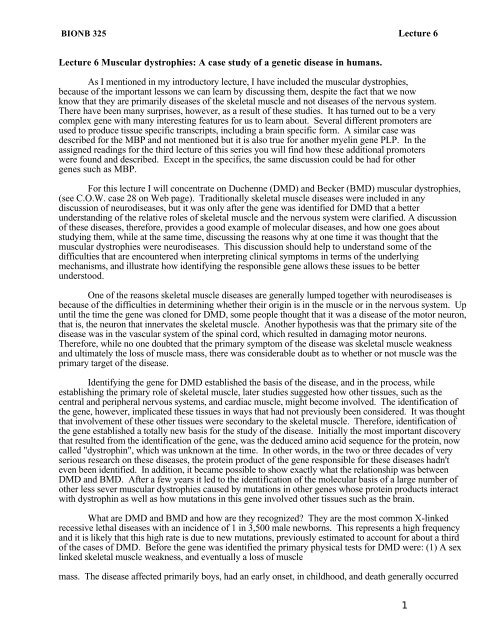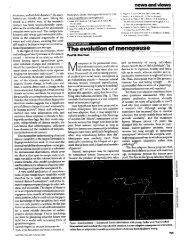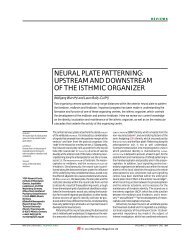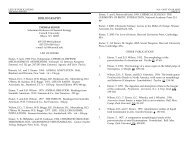Muscular dystrophies: A case study of a genetic disease in humans
Muscular dystrophies: A case study of a genetic disease in humans
Muscular dystrophies: A case study of a genetic disease in humans
Create successful ePaper yourself
Turn your PDF publications into a flip-book with our unique Google optimized e-Paper software.
BIONB 325 Lecture 6<br />
Lecture 6 <strong>Muscular</strong> <strong>dystrophies</strong>: A <strong>case</strong> <strong>study</strong> <strong>of</strong> a <strong>genetic</strong> <strong>disease</strong> <strong>in</strong> <strong>humans</strong>.<br />
As I mentioned <strong>in</strong> my <strong>in</strong>troductory lecture, I have <strong>in</strong>cluded the muscular <strong>dystrophies</strong>,<br />
because <strong>of</strong> the important lessons we can learn by discuss<strong>in</strong>g them, despite the fact that we now<br />
know that they are primarily <strong>disease</strong>s <strong>of</strong> the skeletal muscle and not <strong>disease</strong>s <strong>of</strong> the nervous system.<br />
There have been many surprises, however, as a result <strong>of</strong> these studies. It has turned out to be a very<br />
complex gene with many <strong>in</strong>terest<strong>in</strong>g features for us to learn about. Several different promoters are<br />
used to produce tissue specific transcripts, <strong>in</strong>clud<strong>in</strong>g a bra<strong>in</strong> specific form. A similar <strong>case</strong> was<br />
described for the MBP and not mentioned but it is also true for another myel<strong>in</strong> gene PLP. In the<br />
assigned read<strong>in</strong>gs for the third lecture <strong>of</strong> this series you will f<strong>in</strong>d how these additional promoters<br />
were found and described. Except <strong>in</strong> the specifics, the same discussion could be had for other<br />
genes such as MBP.<br />
For this lecture I will concentrate on Duchenne (DMD) and Becker (BMD) muscular <strong>dystrophies</strong>,<br />
(see C.O.W. <strong>case</strong> 28 on Web page). Traditionally skeletal muscle <strong>disease</strong>s were <strong>in</strong>cluded <strong>in</strong> any<br />
discussion <strong>of</strong> neuro<strong>disease</strong>s, but it was only after the gene was identified for DMD that a better<br />
understand<strong>in</strong>g <strong>of</strong> the relative roles <strong>of</strong> skeletal muscle and the nervous system were clarified. A discussion<br />
<strong>of</strong> these <strong>disease</strong>s, therefore, provides a good example <strong>of</strong> molecular <strong>disease</strong>s, and how one goes about<br />
<strong>study</strong><strong>in</strong>g them, while at the same time, discuss<strong>in</strong>g the reasons why at one time it was thought that the<br />
muscular <strong>dystrophies</strong> were neuro<strong>disease</strong>s. This discussion should help to understand some <strong>of</strong> the<br />
difficulties that are encountered when <strong>in</strong>terpret<strong>in</strong>g cl<strong>in</strong>ical symptoms <strong>in</strong> terms <strong>of</strong> the underly<strong>in</strong>g<br />
mechanisms, and illustrate how identify<strong>in</strong>g the responsible gene allows these issues to be better<br />
understood.<br />
One <strong>of</strong> the reasons skeletal muscle <strong>disease</strong>s are generally lumped together with neuro<strong>disease</strong>s is<br />
because <strong>of</strong> the difficulties <strong>in</strong> determ<strong>in</strong><strong>in</strong>g whether their orig<strong>in</strong> is <strong>in</strong> the muscle or <strong>in</strong> the nervous system. Up<br />
until the time the gene was cloned for DMD, some people thought that it was a <strong>disease</strong> <strong>of</strong> the motor neuron,<br />
that is, the neuron that <strong>in</strong>nervates the skeletal muscle. Another hypothesis was that the primary site <strong>of</strong> the<br />
<strong>disease</strong> was <strong>in</strong> the vascular system <strong>of</strong> the sp<strong>in</strong>al cord, which resulted <strong>in</strong> damag<strong>in</strong>g motor neurons.<br />
Therefore, while no one doubted that the primary symptom <strong>of</strong> the <strong>disease</strong> was skeletal muscle weakness<br />
and ultimately the loss <strong>of</strong> muscle mass, there was considerable doubt as to whether or not muscle was the<br />
primary target <strong>of</strong> the <strong>disease</strong>.<br />
Identify<strong>in</strong>g the gene for DMD established the basis <strong>of</strong> the <strong>disease</strong>, and <strong>in</strong> the process, while<br />
establish<strong>in</strong>g the primary role <strong>of</strong> skeletal muscle, later studies suggested how other tissues, such as the<br />
central and peripheral nervous systems, and cardiac muscle, might become <strong>in</strong>volved. The identification <strong>of</strong><br />
the gene, however, implicated these tissues <strong>in</strong> ways that had not previously been considered. It was thought<br />
that <strong>in</strong>volvement <strong>of</strong> these other tissues were secondary to the skeletal muscle. Therefore, identification <strong>of</strong><br />
the gene established a totally new basis for the <strong>study</strong> <strong>of</strong> the <strong>disease</strong>. Initially the most important discovery<br />
that resulted from the identification <strong>of</strong> the gene, was the deduced am<strong>in</strong>o acid sequence for the prote<strong>in</strong>, now<br />
called "dystroph<strong>in</strong>", which was unknown at the time. In other words, <strong>in</strong> the two or three decades <strong>of</strong> very<br />
serious research on these <strong>disease</strong>s, the prote<strong>in</strong> product <strong>of</strong> the gene responsible for these <strong>disease</strong>s hadn't<br />
even been identified. In addition, it became possible to show exactly what the relationship was between<br />
DMD and BMD. After a few years it led to the identification <strong>of</strong> the molecular basis <strong>of</strong> a large number <strong>of</strong><br />
other less sever muscular <strong>dystrophies</strong> caused by mutations <strong>in</strong> other genes whose prote<strong>in</strong> products <strong>in</strong>teract<br />
with dystroph<strong>in</strong> as well as how mutations <strong>in</strong> this gene <strong>in</strong>volved other tissues such as the bra<strong>in</strong>.<br />
What are DMD and BMD and how are they recognized? They are the most common X-l<strong>in</strong>ked<br />
recessive lethal <strong>disease</strong>s with an <strong>in</strong>cidence <strong>of</strong> 1 <strong>in</strong> 3,500 male newborns. This represents a high frequency<br />
and it is likely that this high rate is due to new mutations, previously estimated to account for about a third<br />
<strong>of</strong> the <strong>case</strong>s <strong>of</strong> DMD. Before the gene was identified the primary physical tests for DMD were: (1) A sex<br />
l<strong>in</strong>ked skeletal muscle weakness, and eventually a loss <strong>of</strong> muscle<br />
mass. The <strong>disease</strong> affected primarily boys, had an early onset, <strong>in</strong> childhood, and death generally occurred<br />
1
BIONB 325 Lecture 6<br />
before the age <strong>of</strong> 30. (2) High blood serum levels <strong>of</strong> creat<strong>in</strong>e k<strong>in</strong>ase (CK). The skeletal muscle is the<br />
pr<strong>in</strong>ciple body source <strong>of</strong> this enzyme, and damaged muscle releases this enzyme <strong>in</strong>to the blood. The<br />
presence <strong>of</strong> high levels <strong>of</strong> this enzyme is <strong>in</strong>dicative <strong>of</strong> damaged skeletal muscle. Carriers <strong>of</strong> the gene can be<br />
detected because they also show elevated levels <strong>of</strong> CK, but not as high as symptomatic <strong>in</strong>dividuals but<br />
higher than normal. (3) While the <strong>in</strong>volvement <strong>of</strong> the skeletal muscle was clear the evidence for the<br />
<strong>in</strong>volvement <strong>of</strong> other tissues was less clear. There are some <strong>in</strong>stances <strong>of</strong> effects on cardiac muscle, and <strong>in</strong><br />
approximately 33% <strong>of</strong> the patients there is a nonprogressive mental retardation. (5) In addition to DMD a<br />
second category <strong>of</strong> muscular <strong>dystrophies</strong> called Becker type muscular dystrophy (BMD) was known to be<br />
also X l<strong>in</strong>ked. These <strong>in</strong>dividuals have symptoms very similar to DMD but the muscle weakness and<br />
progress <strong>of</strong> the <strong>disease</strong> is much less severe than DMD.<br />
As I discuss the gene responsible for DMD and BMD, I will refer back to some <strong>of</strong> these symptoms<br />
as we try to understand the l<strong>in</strong>kage between the gene and the effect <strong>of</strong> its mutation. For example, you might<br />
th<strong>in</strong>k from this discussion that the expression <strong>of</strong> the gene might be limited to skeletal muscle. Or, were the<br />
cardiac problems and mental retardation significant clues to the <strong>in</strong>volvement <strong>of</strong> nonskeletal muscle tissues?<br />
One <strong>of</strong> the major controversies about the mechanism responsible for the <strong>disease</strong> was whether it was<br />
primarily a muscle <strong>disease</strong> or was the muscle degeneration secondary to a malfunction <strong>in</strong> motor neurons, or<br />
some other nervous system failure. I want to spend a few m<strong>in</strong>utes discuss<strong>in</strong>g the nature <strong>of</strong> nerve-muscle<br />
<strong>in</strong>teractions that led people to th<strong>in</strong>k that perhaps muscular <strong>dystrophies</strong> were due primarily to a malfunction<br />
<strong>of</strong> the motor neurons. This was a hotly debated topic until the gene was cloned. Why was this so?<br />
Basically, it was due to the well-known fact that skeletal muscle degenerates when the motor neuron<br />
<strong>in</strong>nervat<strong>in</strong>g it fails. It had been shown, for example, that if you simply cut the nerve <strong>in</strong>nervat<strong>in</strong>g skeletal<br />
muscle, skeletal muscle rapidly beg<strong>in</strong>s to breakdown and muscle mass is lost. Polio might be a <strong>disease</strong> you<br />
are familiar with, <strong>in</strong> which this occurs. The poliovirus affects primarily the motor neurons, but the primary<br />
symptom is muscle weakness and paralysis. Anyth<strong>in</strong>g that prevents the normal activation <strong>of</strong> skeletal<br />
muscle will cause the muscle to beg<strong>in</strong> to breakdown and degenerate. Weightlessness <strong>in</strong> space is another<br />
way <strong>in</strong> which muscle has been shown to breakdown. The peripheral neuropathies (myel<strong>in</strong>opathies) that<br />
result <strong>in</strong> demyel<strong>in</strong>ation also can cause muscle weakness because <strong>of</strong> the lost <strong>of</strong> myel<strong>in</strong> <strong>in</strong> motor axons. The<br />
po<strong>in</strong>t for our present discussion is: Interfere with normal pattern <strong>of</strong> activation <strong>of</strong> skeletal muscle, it beg<strong>in</strong>s<br />
to degenerate. Therefore, if the muscular <strong>dystrophies</strong> had been one <strong>of</strong> the motor neurons, the degeneration<br />
<strong>of</strong> the skeletal muscle would have followed. This was why the conflict developed. Of course, the converse<br />
is also true but more difficult to <strong>study</strong>. If you destroy the muscle, changes <strong>in</strong> the motor neurons occur.<br />
Therefore, it was impossible to tell which came first. This problem was made particularly difficult to <strong>study</strong><br />
<strong>in</strong> <strong>humans</strong> because there was no good animal model <strong>of</strong> the <strong>disease</strong>. It was even worse than it seemed<br />
because as it turned-out, the animal models <strong>in</strong> use for many years were not appropriate ones. They did not<br />
share a common <strong>genetic</strong> cause.<br />
This raises another important po<strong>in</strong>t, which you should be aware <strong>of</strong>. At the time <strong>of</strong> these studies,<br />
there were animal models for <strong>in</strong>herited muscular <strong>dystrophies</strong>. They all caused muscle wast<strong>in</strong>g and an<br />
<strong>in</strong>crease <strong>in</strong> CK. Several <strong>of</strong> them were used, but none <strong>of</strong> the mutations mapped to the X chromosome, until<br />
relatively recently. The fact that there is an extraord<strong>in</strong>ary synteny between the X-chromosomes <strong>in</strong> all<br />
mammals was unrecognized as rul<strong>in</strong>g out all the animal models as be<strong>in</strong>g valid for direct comparison to<br />
DMD. This should alert you to the fact that many th<strong>in</strong>gs can cause muscle degeneration and an <strong>in</strong>crease<br />
<strong>in</strong> CK levels and not be related to DMD. Eventually, a mouse with an <strong>in</strong>herited elevated serum CK level<br />
was found and mapped to the X chromosome, but this animal showed little physical symptoms associated<br />
with the <strong>dystrophies</strong> seen <strong>in</strong> <strong>humans</strong>. For reasons, that is not yet clear, these mice do not suffer nearly as<br />
seriously from<br />
the mutation as <strong>humans</strong> do. The most likely suggestion, although you will learn <strong>of</strong> other possibilities, is<br />
that there is another prote<strong>in</strong>, utroph<strong>in</strong> that is able to substitute for dystroph<strong>in</strong> more effectively <strong>in</strong> mice than<br />
<strong>in</strong> <strong>humans</strong>. For example, if genes for dystroph<strong>in</strong> and utroph<strong>in</strong> are “knocked out” <strong>in</strong> mice, these animals<br />
2
BIONB 325 Lecture 6<br />
have symptoms resembl<strong>in</strong>g DMD. On the other hand, several s<strong>in</strong>gle gene <strong>in</strong>herited muscular<br />
<strong>dystrophies</strong> <strong>in</strong> animals are more sever than the one that turned-out to be most related to DMD. If this<br />
seems impossibly complex, the analysis that we will carryout <strong>in</strong> class will help to understand how these<br />
complexities arise.<br />
The application <strong>of</strong> recomb<strong>in</strong>ant DNA techniques to this problem about fifteen years ago very<br />
quickly changed the entire approach to DMD and BMD, and subsequently other muscle <strong>disease</strong>s. S<strong>in</strong>ce it<br />
too was the first illustration <strong>of</strong> the use <strong>of</strong> positional clon<strong>in</strong>g, it changed the entire approach to many human<br />
<strong>disease</strong>s. Much <strong>of</strong> what we talk about <strong>in</strong> this class evolved from these studies. The one fact that was<br />
necessary, other than the techniques, and <strong>in</strong>spiration to do the experiments, was knowledge that the gene<br />
was on the X chromosome; a fact that had been known for many decades. Genetic l<strong>in</strong>kage analysis and<br />
cytological abnormalities had further identified the gene to be located with<strong>in</strong> chromosomal band Xp21.<br />
These were the important observations, which <strong>in</strong>itiated the clon<strong>in</strong>g work. Therefore, none <strong>of</strong> the other<br />
studies, <strong>of</strong> which their were probably thousands, played any direct role <strong>in</strong> clon<strong>in</strong>g <strong>of</strong> the gene, and many<br />
turned-out to be irrelevant for understand<strong>in</strong>g the mechanism <strong>of</strong> the <strong>disease</strong>.<br />
While the gene had been located to band Xp21, this constitutes a lot <strong>of</strong> DNA, and it conta<strong>in</strong>s an<br />
unknown number <strong>of</strong> genes. How can we identify the specific gene responsible for DMD? Why not start<br />
just as we did with Shiverer? We have <strong>in</strong> the <strong>case</strong> <strong>of</strong> DMD a patient with a <strong>disease</strong>, we know it is <strong>in</strong>herited<br />
and is sex l<strong>in</strong>ked? What else do we need to know? IMPORTANT DIFFERENCE: WE DO NOT<br />
HAVE A CANDIDATE GENE AS WE HAD IN SHIVERER. No gene that was known <strong>in</strong> this<br />
area suggested that it might be a candidate gene.<br />
It is difficult to decide where to beg<strong>in</strong> this discussion because there is not enough time, to discuss<br />
fully the procedures that were used. The details <strong>of</strong> the approach used 15-20 years ago would not be used<br />
today, but I th<strong>in</strong>k that, because <strong>of</strong> the significance <strong>of</strong> this work, at least an outl<strong>in</strong>e <strong>of</strong> it is important. (In fact<br />
I keep expect<strong>in</strong>g these people to receive a Nobel Prize. Maybe this will be their year. I have <strong>in</strong>cluded a<br />
quotation below from Strachan and Read that emphasizes the significance <strong>of</strong> this work.)<br />
A number <strong>of</strong> translocations had been identified <strong>in</strong> <strong>in</strong>dividuals with DMD, and they always <strong>in</strong>volved<br />
breakage <strong>of</strong> the X chromosome at site identified as Xp21. This means that the gene for DMD is located <strong>in</strong><br />
this region, but it still represented a large piece <strong>of</strong> DNA with no way <strong>of</strong> identify<strong>in</strong>g the relevant gene. In<br />
one <strong>of</strong> the DMD patient, a deletion <strong>of</strong> this region was identified cyto<strong>genetic</strong>ally. This observation led to<br />
an effort to identify genes <strong>in</strong> the region <strong>of</strong> the deletion <strong>in</strong> the expectation that one might be responsible for<br />
DMD. Note: It would be <strong>in</strong>correct for you to conclude that the gene for DMD is deleted <strong>in</strong> this <strong>in</strong>dividual.<br />
The hope was that a marker to the deleted region would prove to be close enough, and that it would be<br />
useful for identify<strong>in</strong>g the gene by further studies. As it turned out, as seen below, the deletion is <strong>in</strong> fact <strong>in</strong><br />
the gene for DMD.<br />
Identification <strong>of</strong> the deleted region was done follow<strong>in</strong>g a method loosely called “subtractive<br />
hybridization”. I will not describe this technique, but those <strong>of</strong> you who are <strong>in</strong>terested should read page<br />
382 <strong>in</strong> the 1996 version <strong>of</strong> Strachan and Read. It is a technique that would not be used today. The result<br />
was that they identified the genomic DNA from a normal person that was deleted <strong>in</strong> the boy. Us<strong>in</strong>g this<br />
genomic DNA as a probe for Southern blots done on other DMD boys quickly showed that <strong>in</strong> a small<br />
percentage (6.5%) had deletions <strong>in</strong> this region as well. This started a serious search for a gene <strong>in</strong> the<br />
deleted region. By cutt<strong>in</strong>g the genomic DNA <strong>in</strong>to smaller fragments, and us<strong>in</strong>g them to probe a c-DNA<br />
library from skeletal muscle. This lead to the identification <strong>of</strong> a c-DNA which when tested aga<strong>in</strong>st a large<br />
number <strong>of</strong> DMD boys was partially deleted <strong>in</strong> about 50%. (This is us<strong>in</strong>g genomic DNA from these boys<br />
and do<strong>in</strong>g Southern blots us<strong>in</strong>g the c-DNAs as probes.) This strongly supported a deletion <strong>in</strong> this gene<br />
was responsible for DMD. (What about the 50% that showed no deletions?) The size <strong>of</strong> the c-DNA<br />
identified <strong>in</strong> this manner was eventually shown to be 16kb and the gene 2,400kb(2.4mb). These are<br />
enormous sizes. You should realize that the 2.4mb piece <strong>of</strong> DNA is a factor <strong>of</strong> almost seventy times bigger<br />
than the 37 kb <strong>in</strong>itially identified <strong>in</strong> Shiverer as be<strong>in</strong>g the entire MBP gene, or twenty times as big as the<br />
3
BIONB 325 Lecture 6<br />
105kb later found to be the correct size. This is one <strong>of</strong> the largest genes <strong>in</strong> the human genome and<br />
one <strong>of</strong> the largest prote<strong>in</strong>s.<br />
Several important conclusions can be drawn from this work. Firstly, it should be absolutely clear<br />
that DMD can result from deletions <strong>in</strong> this gene. (2) The deletions are not evenly spaced along the gene<br />
but are clustered. (3) This is the largest human gene found to date. The c-DNA is spread over<br />
approximately 2 million base pairs. The genomic locus is nearly 200 times the size <strong>of</strong> the transcript. This<br />
one gene represents nearly 1/1000 <strong>of</strong> the total human genomic DNA. Ultimately, the prote<strong>in</strong> was identified<br />
as be<strong>in</strong>g 424 kD <strong>in</strong> size. This is an enormous prote<strong>in</strong>, certa<strong>in</strong>ly one <strong>of</strong> the largest, if not the largest. The<br />
prote<strong>in</strong> was named dystroph<strong>in</strong> and I will spend my lecture deal<strong>in</strong>g with the prote<strong>in</strong>. One po<strong>in</strong>t I want to<br />
emphasize to you is that prote<strong>in</strong> was totally unknown until the gene and it c-DNA was identified and<br />
characterized. (4) The size <strong>of</strong> the gene probably partially accounts for the number <strong>of</strong> mutations that occur <strong>in</strong><br />
it. The idea be<strong>in</strong>g, the bigger the gene the more likely mutations will occur. It might also, however, be<br />
concluded that there may be, as well, hot spots with<strong>in</strong> the gene that make it more susceptible to mutations<br />
than it might be otherwise. Two probes cover<strong>in</strong>g only 2kb <strong>of</strong> the total c-DNA detected 80% <strong>of</strong> all the<br />
deletions. This means that 80% <strong>of</strong> the deletions occurred <strong>in</strong> about 15% <strong>of</strong> the total DNA cod<strong>in</strong>g for the<br />
prote<strong>in</strong>. (5) 50% <strong>of</strong> the DMD patients could not be identified as hav<strong>in</strong>g a deletion. Subsequently it was<br />
found that about 30% <strong>of</strong> the DMD patients do not have deletions or duplications. (About 6% have<br />
duplications.) Some have been identified now as hav<strong>in</strong>g missense mutations. (6) Deletions commonly<br />
result <strong>in</strong> much reduced if not total absence <strong>of</strong> dystroph<strong>in</strong>, the prote<strong>in</strong> product <strong>of</strong> this gene <strong>in</strong> skeletal<br />
muscle.<br />
Shortly after the dystroph<strong>in</strong> gene was identified <strong>in</strong> DMD patients, mutations <strong>in</strong> this gene were also<br />
found <strong>in</strong> patients with BMD. As you should recall, I mentioned that BMD was a similar to DMD but later<br />
onset and slower <strong>in</strong> progress and it too was on the X chromosome. This raised the issue as to whether a<br />
comparison between the mutations result<strong>in</strong>g <strong>in</strong> DMD would be more extensive than those found <strong>in</strong> BMD.<br />
At least <strong>in</strong>itially this did not appear to be clear-cut, and it was suggested that perhaps the mutations <strong>in</strong> BMD<br />
resulted <strong>in</strong> the use <strong>of</strong> other start codons with<strong>in</strong> the dystroph<strong>in</strong> gene. The assigned read<strong>in</strong>gs will make the<br />
<strong>case</strong> for BDM be<strong>in</strong>g due to nonframeshift deletions and DMD be<strong>in</strong>g due to frameshift deletions. This<br />
may account for the less sever symptoms seen <strong>in</strong> BDM.<br />
What might be responsible for the 30% <strong>of</strong> the <strong>in</strong>dividuals with DMD who show no<br />
deletions or duplications <strong>in</strong> the dystroph<strong>in</strong> gene? One possible hypothesis is that they don’t have DMD.<br />
The second possibility is that they have mutations <strong>in</strong> the dystroph<strong>in</strong> gene, but the mutations are too small to<br />
be detected with the tests used so far. For example, a missense mutation would not be detected with the<br />
techniques I have described. This is the hypothesis I wish to test, i.e., with an <strong>in</strong>dividual classified as<br />
hav<strong>in</strong>g DMD but with no deletions nor duplications, does he have some other mutation <strong>in</strong> the dystroph<strong>in</strong><br />
gene? The procedure I am go<strong>in</strong>g to describe is PCR based. In discussion I will discuss this technique<br />
briefly, but you should refer to any number <strong>of</strong> textbooks, if you have questions about how PCR is done. It<br />
is extremely important that you understand the basic pr<strong>in</strong>ciples beh<strong>in</strong>d PCR.<br />
Firstly, let us look at what the results would look like if there were a deletion for this <strong>in</strong>dividual. As<br />
you should recall <strong>in</strong> order to perform PCR you must have two primers. The primers used <strong>in</strong> these studies<br />
are ones based on the sequence <strong>of</strong> the dystroph<strong>in</strong> gene. One exon at a time is amplified by PCR. The<br />
transparency shows several exons, which have the normal size, but two <strong>in</strong>dividuals are miss<strong>in</strong>g one exon.<br />
This is a straightforward use <strong>of</strong> PCR. Let me rem<strong>in</strong>d you however, there are 79 exons <strong>in</strong> the dystroph<strong>in</strong><br />
gene. Clearly, to look at all 79 would not be practical except <strong>in</strong> a research environment. Fortunately, we<br />
know from my earlier discussion that most deletions are found <strong>in</strong> a small number <strong>of</strong> exons. This means<br />
that an <strong>in</strong>itial survey <strong>of</strong> these exons would be a good strategy, and only then search the other exons if<br />
noth<strong>in</strong>g was detected <strong>in</strong> the most frequently affected exons.<br />
The question now, however, is what about those <strong>in</strong>dividuals who don’t show any deletions?<br />
4
BIONB 325 Lecture 6<br />
The assigned read<strong>in</strong>g by Prior et al., describes one such boy who at the age <strong>of</strong> 8 appears to<br />
have a sever form <strong>of</strong> DMD but with no deletions or duplications <strong>in</strong> the dystroph<strong>in</strong> gene. Does he <strong>in</strong> fact<br />
have DMD? In order to test this question they amplified several exons, just as I described above, but <strong>in</strong><br />
addition to look<strong>in</strong>g at the presence or absence <strong>of</strong> the exon they determ<strong>in</strong>ed whether the exons carried a<br />
missense mutation. They did this with a heteroduplex analysis. Heteroduplex analysis is done by<br />
hybridiz<strong>in</strong>g the wild-type PCR product with the product from the patient. The product with the DNA from<br />
the patient will b<strong>in</strong>d to the wild-type DNA, but it will migrate anomalously on a special gel electrophoresis.<br />
That is, because the two cha<strong>in</strong>s <strong>of</strong> DNA are very similar, but potentially with only one base substitution, the<br />
heteroduplex will migrate differently from the homoduplex. Us<strong>in</strong>g this technique, this patient was found to<br />
have a one base substitution, which results <strong>in</strong> the substitution <strong>of</strong> a leuc<strong>in</strong>e for an arg<strong>in</strong><strong>in</strong>e <strong>in</strong> exon number 3.<br />
This paper beg<strong>in</strong>s with the use <strong>of</strong> PCR to amplify specific sequences <strong>of</strong> DNA, i.e., make many<br />
copies <strong>of</strong> s<strong>in</strong>gle exon. The same exon is amplified from a control person as well as the boy with DMD.<br />
Follow<strong>in</strong>g the PCR reaction the DNA products are run <strong>in</strong> a special gel electrophoresis system called<br />
“Hydrol<strong>in</strong>k”. The DNA products are mixed, denatured at a high temperature caus<strong>in</strong>g the DNA strands to<br />
come apart, and then the temperature is lowered allow<strong>in</strong>g the strands to reanneal. When they reanneal, three<br />
types <strong>of</strong> double strands can form: (1) homoduplexes <strong>of</strong> normal DNA, (2) homoduplexes conta<strong>in</strong><strong>in</strong>g the<br />
missence mutation and (3) heteroduplexes formed from the DNA <strong>of</strong> the normal DNA and the DNA<br />
conta<strong>in</strong><strong>in</strong>g the mutation. Base pair<strong>in</strong>g <strong>in</strong> the heteroduplex will not be perfect, if there is one or more base<br />
differences between the two DNAs. This difference <strong>in</strong> base pair<strong>in</strong>g can be detected on the “Hydrol<strong>in</strong>k”<br />
gel follow<strong>in</strong>g electrophoresis, see Fig 1 <strong>of</strong> Prior et al..<br />
The PCR products must then be sequenced <strong>in</strong> order to establish the presence and nature <strong>of</strong> the<br />
mutation. This is the way the missence mutation was identified <strong>in</strong> this young boy. You should pay special<br />
attention to this paper, and its discussion <strong>of</strong> the relationship between mutation and phenotype. Also, notice<br />
that despite this boy hav<strong>in</strong>g DMD, he did have dystroph<strong>in</strong> <strong>in</strong> his skeletal muscle located <strong>in</strong> the correct<br />
place; only the amount <strong>of</strong> dystroph<strong>in</strong> seems to be lower. Clearly, this mutation is seriously disrupt<strong>in</strong>g the<br />
normal function <strong>of</strong> dystroph<strong>in</strong>.<br />
The other aspect <strong>of</strong> this paper you should <strong>study</strong> is shown <strong>in</strong> Fig. 3. This describes the results <strong>of</strong> a<br />
l<strong>in</strong>kage <strong>study</strong> between the DMD gene and microsatellites, i.e., short CA repeats <strong>in</strong> the dystroph<strong>in</strong> gene<br />
which can be used as polymorphic markers <strong>in</strong> the same way that restriction sites can be used. The<br />
haplotype assignments were based on the molecular size <strong>of</strong> the PCR products. This is a similar analysis to<br />
the haplotypes assignments based on the restriction endonuclease polymorphism. I have not described<br />
RFLP haplotype analysis yet, but I will shortly, for those <strong>of</strong> you who are unfamiliar with it. Our first <strong>case</strong><br />
<strong>of</strong> such an analysis will appear <strong>in</strong> Alzheimer’s <strong>disease</strong>. The best description, however, is <strong>in</strong> a later paper by<br />
Gusella et al., if you want to jump ahead.<br />
Does the f<strong>in</strong>d<strong>in</strong>g <strong>of</strong> the missense mutation prove that this boy has DMD? How do you<br />
know that this substitution is not simply a rare polymorphism that has no effect on the function <strong>of</strong><br />
dystroph<strong>in</strong>? There are several po<strong>in</strong>ts that must be made <strong>in</strong> answer<strong>in</strong>g this question. One, the<br />
pedigree didn’t show the substitution to be a polymorphism. In fact the pedigree suggested that the<br />
mutation was a new one and occurred between the grandmother and mother <strong>of</strong> the boy with DMD.<br />
Secondly, the observation <strong>of</strong> reduced levels <strong>of</strong> dystroph<strong>in</strong> <strong>in</strong> this <strong>in</strong>dividual’s skeletal muscle<br />
<strong>in</strong>dicates that the mutation does affect the function <strong>of</strong> dystroph<strong>in</strong>, if only by reduc<strong>in</strong>g the amount<br />
found <strong>in</strong> skeletal muscle. This result shows that the complete absence <strong>of</strong> dystroph<strong>in</strong> is not required<br />
for an <strong>in</strong>dividual to have DMD.<br />
5
BIONB 325 Lecture 6<br />
“Duchenne muscular dystrophy (DMD)<br />
was a major test-bed for positional clon<strong>in</strong>g<br />
methods. Years <strong>of</strong> careful <strong>in</strong>vestigation <strong>of</strong> the<br />
pathological changes <strong>in</strong> affected muscle had<br />
failed to reveal the biochemical basis <strong>of</strong> DMD.<br />
In the early 1980s, several groups competed<br />
to clone the DMD gene, us<strong>in</strong>g different<br />
approaches. The pioneer<strong>in</strong>g work <strong>of</strong> these<br />
groups, overcom<strong>in</strong>g formidable technical<br />
difficulties to clone an unprecedented gene,<br />
was probably the major <strong>in</strong>spiration for most<br />
subsequent positional clon<strong>in</strong>g efforts.”<br />
Human Molecular Genetics (1999) Strachan and Read<br />
6












